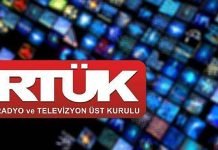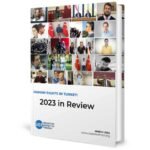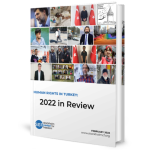Turkish authorities have reportedly exhumed 267 corpses, which were belong to Kurdish militants who were mostly killed as they fought against radical Islamist terror group Islamic State of Iraq and the Levant (ISIL) on the ranks of various Kurdish groups, in Garzan district of Bitlis province and taken away.
Mahmut Celadet Gaydalı, Bitlis deputy of the pro-Kurdish Peoples’ Democratic Party (HDP) said during a press conference at the Turkish Parliament that the government had begun “targeting the dead” after ending the 2013-15 peace talks with the outlawed Kurdistan Workers’ Party (PKK). Gaydali stated that the cemetery in his home city’s Yukariolek (Oleka Jor) village was built collectively by families of militants killed and there was no intervention or obstruction by authorities when they did so in 2013.
According to a report by pro-Kurdish Fırat news agency on Friday, all the graves belong to the killed Kurdish militants, were completely destroyed in Garzan Cemetery in Bitlis province. The report said “Corpses of 267 HPG, YJA Star guerrillas and YPG/YPJ fighters buried here were exhumed, including the body of YPJ (Women’s Defense Units) fighter Dilan Bingöl, who had lost her life during Kobane resistance in 2014.”
YPJ fighter’s father Lezgin Bingöl, who made a statement on social media, said that “This graveyard is known as Garzan Cemetery of Martyrs. After hearing that the cemetery had been demolished by security forces recently, I submitted a written appeal to Bitlis Governor Office on December 18, 2017. My daughter Dilan Bingöl was also buried there. In my appeal, I stated that I wanted to visit my daughter’s grave and asked to be informed if there was a prohibition on that region. The Governorate officials referred my appeal to the gendarmerie on the grounds that the area was under the gendarmerie’s control. On December 19, gendarmerie called me and said ‘267 corpses in that cemetery were exhumed and sent to İstanbul Forensic Medicine Institute on the governorate’s instruction’.
“I then went to the cemetery in the village of Yukarı Ölek on December 20. There I saw that my daughter’s grave was not there. The grave had been demolished and my daughter’s bones had been exhumed and taken away. There is nothing left of the graves in the cemetery,” said Bingöl and added “When I looked around, I saw that all the other graves were in the same situation. I therewith appealed to Bitlis Chief Prosecutor’s Office on December 21. I wanted to learn about the aftermath of my daughter’s corpse and filed a criminal complaint against those responsible.”
Bingöl stated that they had already buried their daughter there after receiving a burial and transfer permit from the Forensic Medicine Institute of Şanlıurfa and continued “An investigation was launched against me and my wife in connection with the burial afterwards. We stood trial and we were acquitted.”
Bingöl has also claimed that his daughter being subject to repeated forensic medicine procedures despite her clear identity being known.
“The regime has started mistreating even the dead. It has rotten and crossed all moral lines. Humanity has died [under that rule],” said a press release on the website of the HDP condemning the Turkish government. It accused Turkish autocratic President Recep Tayyip Erdoğan’s ruling Justice and Development Party (AKP) of engaging in oppression that “did not occur to other tyrants.”
“Even the most barbarian armies did not ignore the right to be buried, something that does not require any written laws,” read the HDP statement signed by Ayşe Acar Başaran.
“What kind of mental state it is that [Turkey] arranges funerals for the ANZACs who came to invade but destroys graves in Bitlis,” HDP Spokesperson Ayhan Bilgen asked on Twitter by referring to annual commemorations in western Turkey to honor the memory of British Empire’s Australian and New Zealander soldiers who died fighting the Ottomans in Gallipoli front during World War One.
The siege of Kobane was launched by ISIL on September 13, 2014, in order to capture the Kobane Canton and its main city of Kobane (also known as Ayn al-Arab) in northern Syria. ISIL succeeded in capturing 350 Kurdish villages and towns within the vicinity of Kobane, generating a wave of some 400,000 displaced Kurds, who fled across the border into Turkey’s Şanlıurfa province.
The Kurdish People’s Protection Units (YPG) backed by Euphrates Volcano joint operations room, some Free Syrian Army(FSA) reinforcements, heavily armed Peshmerga of the Iraqi Kurdistan Regional Government (KRG), and American and US-allied Arab militaries’ airstrikes began to recapture Kobane in January 2015 and pushed ISIL into a steady retreat. The city of Kobanê was fully recaptured on January 26, 2015. The battle for Kobane was considered a turning point in the war against ISIL.
In September 20017, troops acting under orders of an Ankara-appointed governor in the Kurdish province of Bingol demolished the grave of a Peshmerga volunteer, Sait Çürükkaya, who was killed during the Kurdish-Iraqi offensive to capture the then ISIL-held city of Mosul in 2016.















